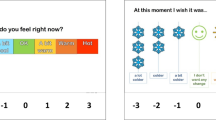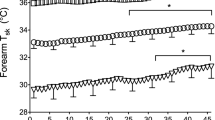Abstract
To approach the mechanisms underlying the underdeveloped sweating responses of prepubertal boys, 8 boys (7–11 years old) and 11 men (21–25 years old) were exposed to a standard heat stress for 60 min. The test consisted of placing the subjects' lower legs into a 42°C water bath while they sat in otherwise constant environmental conditions (ambient temperature 25°C and 45% relative humidity). Rectal (T re) and skin temperatures, local sweating rates (m˙ sw: on the chest, back, forearm and thigh) and the frequency of sweating expulsions ( f sw: as an indicator of central sudomotor activity) were measured during the test. During the passive heating, no group differences were observed for the increase in T re, mean skin temperature and metabolic heat production. However, mean body temperature (T¯ b) during heating was significantly higher for the boys (P<0.001) because of a higher baseline T re. The boys had lower m˙ sw on the chest (P<0.004) and thigh (P<0.001) during the latter half of the 60-min exposure compared to the young men, although a similar m˙ sw was observed between the groups during the first half of the test. The group difference of m˙ sw on the back was similar to that of the chest and thigh, but the difference was not significant (P=0.10). In contrast, the boys had a greater m˙ sw on the forearm throughout the heating (P<0.03). The slope of the m˙ sw vs f sw relationship was significantly lower for the chest and thigh in the boys compared to the men (P<0.05), and the same tendency was observed for the back (but was not significant, P=0.10). In contrast, no difference was observed between the groups for the slope of m˙ sw vs f sw for the forearm. Furthermore, a lower sweat output per gland was also observed on the chest, back, and thigh in the boys (P<0.01), but not on the forearm. No group difference was observed for the slope of the f sw vs T¯ b relationship. These results suggest that the lower m˙ sw observed in the prepubertal boys were due possibly to underdeveloped peripheral mechanisms, including the sweat glands and their surrounding tissues, rather than to an underdeveloped central drive activity related to sudomotor function. Regional differences may well exist in any underdeveloped peripheral mechanism associated with maturation.
Similar content being viewed by others
Author information
Authors and Affiliations
Additional information
Accepted: 13 March 1997
Rights and permissions
About this article
Cite this article
Shibasaki, M., Inoue, Y. & Kondo, N. Mechanisms of underdeveloped sweating responses in prepubertal boys. Eur J Appl Physiol 76, 340–345 (1997). https://doi.org/10.1007/s004210050258
Issue Date:
DOI: https://doi.org/10.1007/s004210050258




